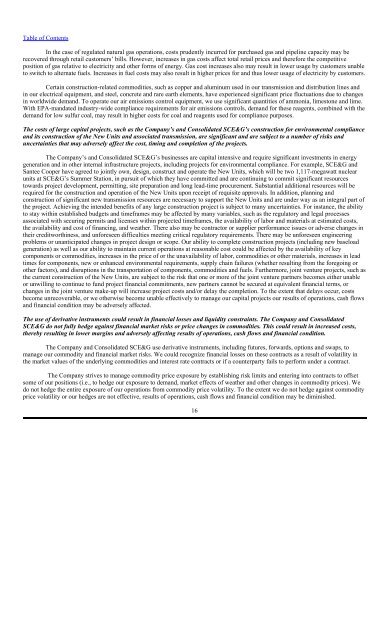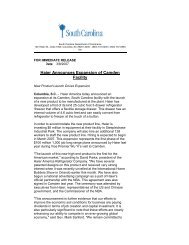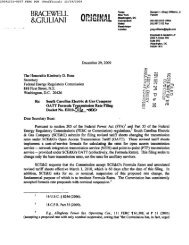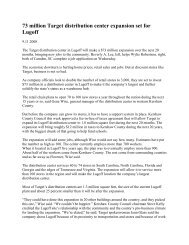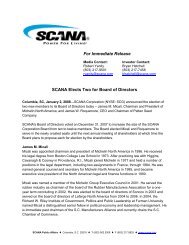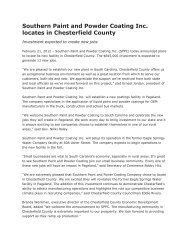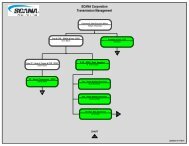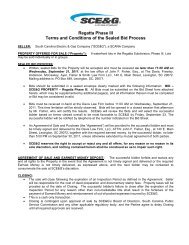10-K - SCANA Corporation
10-K - SCANA Corporation
10-K - SCANA Corporation
Create successful ePaper yourself
Turn your PDF publications into a flip-book with our unique Google optimized e-Paper software.
Table of Contents<br />
In the case of regulated natural gas operations, costs prudently incurred for purchased gas and pipeline capacity may be<br />
recovered through retail customers’ bills. However, increases in gas costs affect total retail prices and therefore the competitive<br />
position of gas relative to electricity and other forms of energy. Gas cost increases also may result in lower usage by customers unable<br />
to switch to alternate fuels. Increases in fuel costs may also result in higher prices for and thus lower usage of electricity by customers.<br />
Certain construction-related commodities, such as copper and aluminum used in our transmission and distribution lines and<br />
in our electrical equipment, and steel, concrete and rare earth elements, have experienced significant price fluctuations due to changes<br />
in worldwide demand. To operate our air emissions control equipment, we use significant quantities of ammonia, limestone and lime.<br />
With EPA-mandated industry-wide compliance requirements for air emissions controls, demand for these reagents, combined with the<br />
demand for low sulfur coal, may result in higher costs for coal and reagents used for compliance purposes.<br />
The costs of large capital projects, such as the Company’s and Consolidated SCE&G’s construction for environmental compliance<br />
and its construction of the New Units and associated transmission, are significant and are subject to a number of risks and<br />
uncertainties that may adversely affect the cost, timing and completion of the projects.<br />
The Company’s and Consolidated SCE&G’s businesses are capital intensive and require significant investments in energy<br />
generation and in other internal infrastructure projects, including projects for environmental compliance. For example, SCE&G and<br />
Santee Cooper have agreed to jointly own, design, construct and operate the New Units, which will be two 1,117-megawatt nuclear<br />
units at SCE&G’s Summer Station, in pursuit of which they have committed and are continuing to commit significant resources<br />
towards project development, permitting, site preparation and long lead-time procurement. Substantial additional resources will be<br />
required for the construction and operation of the New Units upon receipt of requisite approvals. In addition, planning and<br />
construction of significant new transmission resources are necessary to support the New Units and are under way as an integral part of<br />
the project. Achieving the intended benefits of any large construction project is subject to many uncertainties. For instance, the ability<br />
to stay within established budgets and timeframes may be affected by many variables, such as the regulatory and legal processes<br />
associated with securing permits and licenses within projected timeframes, the availability of labor and materials at estimated costs,<br />
the availability and cost of financing, and weather. There also may be contractor or supplier performance issues or adverse changes in<br />
their creditworthiness, and unforeseen difficulties meeting critical regulatory requirements. There may be unforeseen engineering<br />
problems or unanticipated changes in project design or scope. Our ability to complete construction projects (including new baseload<br />
generation) as well as our ability to maintain current operations at reasonable cost could be affected by the availability of key<br />
components or commodities, increases in the price of or the unavailability of labor, commodities or other materials, increases in lead<br />
times for components, new or enhanced environmental requirements, supply chain failures (whether resulting from the foregoing or<br />
other factors), and disruptions in the transportation of components, commodities and fuels. Furthermore, joint venture projects, such as<br />
the current construction of the New Units, are subject to the risk that one or more of the joint venture partners becomes either unable<br />
or unwilling to continue to fund project financial commitments, new partners cannot be secured at equivalent financial terms, or<br />
changes in the joint venture make-up will increase project costs and/or delay the completion. To the extent that delays occur, costs<br />
become unrecoverable, or we otherwise become unable effectively to manage our capital projects our results of operations, cash flows<br />
and financial condition may be adversely affected.<br />
The use of derivative instruments could result in financial losses and liquidity constraints. The Company and Consolidated<br />
SCE&G do not fully hedge against financial market risks or price changes in commodities. This could result in increased costs,<br />
thereby resulting in lower margins and adversely affecting results of operations, cash flows and financial condition.<br />
The Company and Consolidated SCE&G use derivative instruments, including futures, forwards, options and swaps, to<br />
manage our commodity and financial market risks. We could recognize financial losses on these contracts as a result of volatility in<br />
the market values of the underlying commodities and interest rate contracts or if a counterparty fails to perform under a contract.<br />
The Company strives to manage commodity price exposure by establishing risk limits and entering into contracts to offset<br />
some of our positions (i.e., to hedge our exposure to demand, market effects of weather and other changes in commodity prices). We<br />
do not hedge the entire exposure of our operations from commodity price volatility. To the extent we do not hedge against commodity<br />
price volatility or our hedges are not effective, results of operations, cash flows and financial condition may be diminished.<br />
16


